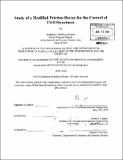Study of a Modified Friction Device for the control of civil structures
Author(s)
Abdellaoui Maane, Mohamed
DownloadFull printable version (11.92Mb)
Alternative title
Study of a MFD for the control of civil structures
Other Contributors
Massachusetts Institute of Technology. Dept. of Civil and Environmental Engineering.
Advisor
Jerome J. Connor.
Terms of use
Metadata
Show full item recordAbstract
In structural engineering, vibrations created by transient loads input energy to the structure. Control devices can be used to dissipate this energy in a civil structure. In this research, a new semi-active dissipation device is studied: the Modified Friction Device (MFD). The MFD is a control device that consists of a spring, a viscous element and a braking element similar to car brakes. Because it is still a conceptual design, the device's frictional behavior has been modeled using the LuGre friction model that takes the stiction and Stribeck effect into account in the dynamic behavior. Then, several simulations have been run to evaluate how the device behaves and how it dissipates energy in a structure under seismic and wind loads. Three interesting results emerged. Firstly, the LuGre friction model is a very good approximation for this device, as the comparison between experimental data from a friction device and the model to adapt the model parameters showed. Secondly, the MFD can display a behavior similar to the MR damper but with a more mechanically robust and reliable system. Thirdly, several control schemes have been implemented and the MFD can be used as a force actuator as well as a passive device. Furthermore, this device meets realistic constraints of control and constructability.
Description
Thesis (M. Eng.)--Massachusetts Institute of Technology, Dept. of Civil and Environmental Engineering, 2009. Cataloged from PDF version of thesis. Includes bibliographical references (p. 79-82).
Date issued
2009Department
Massachusetts Institute of Technology. Department of Civil and Environmental EngineeringPublisher
Massachusetts Institute of Technology
Keywords
Civil and Environmental Engineering.